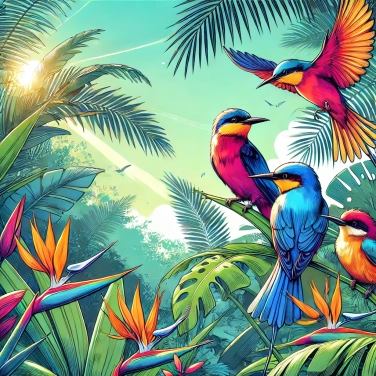Birds sporting bright colors often live in the tropics because these colors help them blend in with the lush vegetation and attract a partner for reproduction.

In birds, bright colors are often obtained through specific pigments, such as carotenoids. These pigments come directly from their diet, mainly from fruits, flowers, or insects, which are abundant in tropical environments. The warm, humid climate rich in vegetation of the tropics truly offers a varied menu, rich in these molecules necessary for vibrant coloration. On the other hand, other more bluish or iridescent colors appear thanks to physical tricks, such as light reflected by the very structure of the feathers (structural colors). These chromatic characteristics primarily serve to camouflage themselves among the foliage, signal their presence to their peers, or attract a mate in a boldly ostentatious manner. These specific adaptations provide them with real advantages for surviving and reproducing in an environment where competition is quite fierce.
In tropical areas, hundreds of bird species live side by side in very limited territories, which creates quite a bit of competition. To clearly distinguish themselves from neighboring species, tropical birds often rely on vivid colors. These hues serve as clear visual signals, facilitating recognition among peers and avoiding misunderstandings during courtship rituals. In many species, color vibrancy is also a sign of good health, allowing individuals to easily prove their worth to potential mates. The more colorful and contrasting a bird is, the more it attracts the attention of its surroundings and gains visibility for effective reproduction.
The tropics are teeming with an incredible variety of plant and animal species. This high biodiversity provides birds with a varied diet, rich in carotenoids, the pigments that give bright colors. Exotic fruits, multicolored berries, diverse insects— the more varied their diet, the more they accumulate these pigments in their plumage. Some tropical foods are particularly rich in natural pigments, so the birds that feed on them often display spectacular colors. Without such an abundance of food, maintaining these bright hues would be simply impossible.
These bright colors may seem risky, as they make birds highly visible to potential predators. But in reality, they often serve as a subtly effective survival strategy. Some of these tropical birds sport flashy colors to clearly warn: "Beware, I am toxic or unpleasant to eat!" This is known as aposematism. Others outright bluff by mimicking the colors of dangerous species to deceive predators. This is the principle of mimicry. Ultimately, these colors are not just decoration: they are a true strategic weapon in a thriving ecosystem, where the pressure from predators drives each to find their own techniques for survival.
The vibrant colors of tropical birds play an essential role in their social interactions and mate selection: the brighter and more distinct the colors, the more the individual is perceived as attractive and healthy.
Some tropical birds display bright colors to signal to predators that they are toxic or dangerous to eat; a strategy known as aposematism, which is often observed in tropical insects such as butterflies as well.
Birds living near the equator benefit from greater plant and animal biodiversity, allowing them to access a varied diet rich in natural pigments, thereby promoting the development of their bright colors.
The toucan has an extremely lightweight beak despite its large size; its hollow internal structure allows it to maintain a minimal weight while remaining strong and effective in the tropical climate.
The bright colors observed in many tropical birds primarily come from carotenoid pigments, melanins, and porphyrins present in their diet. Carotenoids, for example, are widely found in fruits and flowers and give birds their vibrant shades of red, orange, or yellow.
Even though a diet rich in pigments is important, birds in temperate regions will not automatically have colors as vibrant simply by adopting a similar diet. Coloration heavily depends on specific genetic and evolutionary factors related to tropical environments, such as sexual selection, increased visual competition, and rich biodiversity in the ecosystem.
Sure! Here’s the translation: "Yes, potentially. Bright colors can increase a bird's visibility to predators. However, in a tropical environment rich in dense vegetation and vibrant colors, certain colorations can act as camouflage by breaking up the bird's silhouette. Furthermore, the evolution of bright colors is often linked to reproductive or social communication benefits that outweigh this risk."
Yes, the vibrant colors of tropical birds are often an indicator of health and vitality. A bright color frequently indicates a good diet, an efficient metabolism, and a relative absence of parasites, which is an asset for attracting a mate during reproduction.
No, not all birds in tropical regions are necessarily colorful. While a wide variety of tropical species display bright colors, some have dull or subdued plumage to better camouflage themselves, avoid predators, or adapt to their specific way of life.

No one has answered this quiz yet, be the first!' :-)
Question 1/5